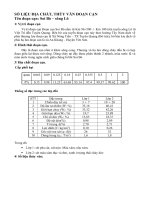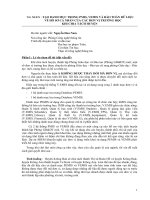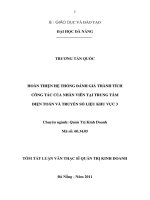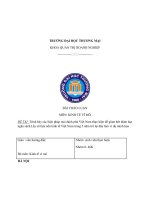Ch3 2 v1 TRUYỀN SỐ LIỆU VÀ MẠNG
Bạn đang xem bản rút gọn của tài liệu. Xem và tải ngay bản đầy đủ của tài liệu tại đây (441.22 KB, 26 trang )
Chapter 3
Data and Signals
3.1
Copyright © The McGraw-Hill Companies, Inc. Permission required for reproduction or display.
3-3 DIGITAL SIGNALS
In addition to being represented by an analog signal,
information can also be represented by a digital signal.
For example, a 1 can be encoded as a positive voltage
and a 0 as zero voltage. A digital signal can have more
than two levels. In this case, we can send more than 1 bit
for each level.
Topics discussed in this section:
Bit Rate
Bit Length
Digital Signal as a Composite Analog Signal
Application Layer
3.2
Figure 3.16 Two digital signals: one with two signal levels and the other
with four signal levels
3.3
Example 3.16
A digital signal has eight levels. How many bits are
needed per level? We calculate the number of bits from
the formula
Each signal level is represented by 3 bits.
3.4
Example 3.17
A digital signal has nine levels. How many bits are
needed per level? We calculate the number of bits by
using the formula. Each signal level is represented by
3.17 bits. However, this answer is not realistic. The
number of bits sent per level needs to be an integer as
well as a power of 2. For this example, 4 bits can
represent one level.
3.5
Example 3.18
Assume we need to download text documents at the rate
of 100 pages per sec. What is the required bit rate of the
channel?
Solution
A page is an average of 24 lines with 80 characters in
each line. If we assume that one character requires 8
bits (ascii), the bit rate is
3.6
Example 3.19
A digitized voice channel, as we will see in Chapter 4, is
made by digitizing a 4-kHz bandwidth analog voice
signal. We need to sample the signal at twice the highest
frequency (two samples per hertz). We assume that each
sample requires 8 bits. What is the required bit rate?
Solution
The bit rate can be calculated as
3.7
Example 3.20
What is the bit rate for high-definition TV (HDTV)?
Solution
HDTV uses digital signals to broadcast high quality
video signals. The HDTV screen is normally a ratio of
16 : 9. There are 1920 by 1080 pixels per screen, and the
screen is renewed 30 times per second. Twenty-four bits
represents one color pixel.
The TV stations reduce this rate to 20 to 40 Mbps
through compression.
3.8
Figure 3.17 The time and frequency domains of periodic and nonperiodic
digital signals
3.9
Figure 3.18 Baseband transmission
3.10
Note
A digital signal is a composite analog
signal with an infinite bandwidth.
3.11
Figure 3.19 Bandwidths of two low-pass channels
3.12
Figure 3.20 Baseband transmission using a dedicated medium
3.13
Note
Baseband transmission of a digital
signal that preserves the shape of the
digital signal is possible only if we have
a low-pass channel with an infinite or
very wide bandwidth.
3.14
Example 3.21
An example of a dedicated channel where the entire
bandwidth of the medium is used as one single channel
is a LAN. Almost every wired LAN today uses a
dedicated channel for two stations communicating with
each other. In a bus topology LAN with multipoint
connections, only two stations can communicate with
each other at each moment in time (timesharing); the
other stations need to refrain from sending data. In a
star topology LAN, the entire channel between each
station and the hub is used for communication between
these two entities.
3.15
Figure 3.21 Rough approximation of a digital signal using the first harmonic
for worst case
3.16
Figure 3.22 Simulating a digital signal with first three harmonics
3.17
Note
In baseband transmission, the required
the bit rate;
bandwidth is proportional
to the bit rate;
if weneed
need to send
bits faster,
we need
more bandwidth.
if we
to send
bits
faster,
we need
more bandwidth.
In baseband transmission, the required bandwidth is proportional to
3.18
Table 3.2 Bandwidth requirements
3.19
Example 3.22
What is the required bandwidth of a low-pass channel if
we need to send 1 Mbps by using baseband transmission?
Solution
The answer depends on the accuracy desired.
a. The minimum bandwidth, is B = bit rate /2, or 500 kHz.
b. A better solution is to use the first and the third
harmonics with B = 3 × 500 kHz = 1.5 MHz.
c. Still a better solution is to use the first, third, and fifth
harmonics with B = 5 × 500 kHz = 2.5 MHz.
3.20









